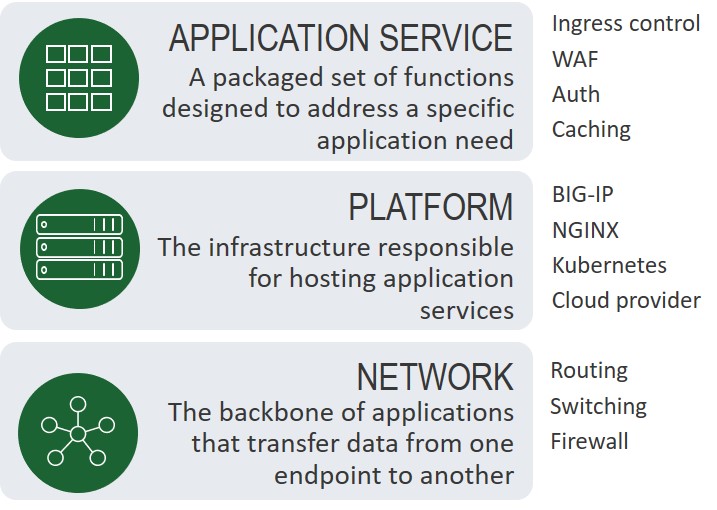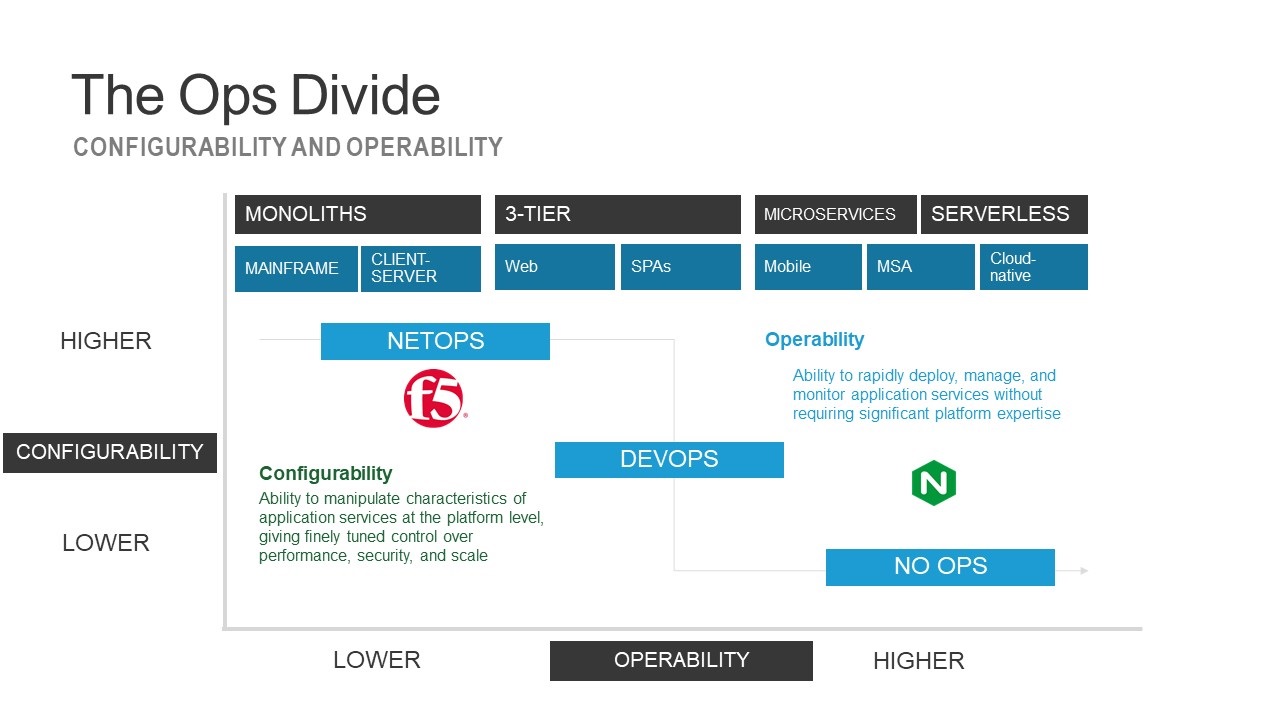A divisão entre configurabilidade e operacionalidade
Tivemos vários blogs sobre a divisão entre entrega (desenvolvimento de aplicativos) e implantação (produção) estimulados por nossa recente aquisição da NGINX . Um deles abordou brevemente um conceito que hoje vamos explorar: simplicidade operacional .
Por trás da frase "simplicidade operacional" existe uma divisão entre configurabilidade e operabilidade. Os dois contrastam fortemente um com o outro. Por um lado, está a configurabilidade. Essa é a capacidade de manipular características de serviços de aplicativos nas camadas de rede, plataforma e serviços de aplicativos. É o que lhe dá a capacidade de ativar e desativar o algoritmo de Nagle e ajustar as configurações que afetam o desempenho e a eficiência dos protocolos.

Por outro lado está a operabilidade. Essa é a capacidade de implantar, gerenciar e monitorar rapidamente serviços de aplicativos. A expectativa de operabilidade é o conhecimento do serviço do aplicativo e pouco mais. Não há exigência de que os operadores sejam especialistas nas camadas de plataforma ou rede. Para conseguir isso, os botões e controles existentes na camada de serviço do aplicativo podem ser restritos. O objetivo principal é tornar o serviço do aplicativo fácil de implantar e operar.
Uma delas introduz complexidade. Um reduz isso. É preciso profundidade e amplitude de conhecimento em todo o conjunto. O outro não. Cada um desempenha um papel na entrega segura de aplicativos.
Divisão de Deveres
O motivo pelo qual essa divisão é importante é porque a nuvem e os contêineres estão pressionando a infraestrutura de serviços de aplicativos a mudar para um modelo mais simples. Vários serviços de aplicativos estão sendo consumidos por contêineres. Balanceamento de carga, controle de entrada, monitoramento, gateways de API e segurança de API são vistos como componentes necessários para uma estratégia de conteinerização bem-sucedida. Essencialmente, a transformação das arquiteturas está dividindo os próprios serviços de aplicativos. Alguns são mais adequados para implantação no caminho de dados e outros como parte da arquitetura do aplicativo.
Isso significa que cada vez mais são as operações — especificamente o DevOps — que estão consumindo serviços de aplicativos no local e na nuvem pública. Isso tem um impacto profundo nesses serviços de aplicativos porque as expectativas do DevOps incluem operabilidade em vez de configurabilidade. O DevOps não está particularmente interessado em ajustar pilhas TCP; ele está interessado em implantações rápidas e frequentes e em manter a disponibilidade dos aplicativos.

Isso se deve em grande parte ao foco no tempo de retorno do investimento, que exige maior velocidade de entrega e implantação. Ninguém tem tempo para mexer em infraestrutura, eles têm aplicativos para colocar no mercado.
Mas isso não significa que a configurabilidade não seja importante. Sim, principalmente quando se trata de segurança e desempenho. Uma rede padronizada e uma pilha de plataforma não são otimizadas para nada. Ele não consegue se ajustar para otimizar para dispositivos móveis ao mesmo tempo em que otimiza para desktop. Ele não é otimizado para sua rede, seja na nuvem ou no local.
E, quer queiramos admitir ou não, o desempenho é uma medida composta. Se sua rede estiver lenta, seu aplicativo ficará mais lento. A necessidade de otimizar nas camadas de rede e plataforma é um componente crítico para garantir não apenas a disponibilidade, mas também o desempenho . Isso faz com que a configurabilidade seja algo que precisa estar disponível para aqueles que podem tirar proveito dela.
Não é uma escolha binária
A configurabilidade continua sendo tão importante quanto a operabilidade. Não é realmente uma escolha binária porque o consumo de serviços de aplicativos não é binário. Hoje, tanto o NetOps quanto o DevOps consomem serviços de aplicativos; a divisão está em suas expectativas em relação à implantação e ao gerenciamento desses serviços de aplicativos. O NetOps precisa de configurabilidade. DevOps requer operabilidade.
O negócio precisa de ambos, porque a velocidade de entrega ao mercado não ajudará se seu aplicativo também não for rápido e confiável.
Essa divisão existe porque a tecnologia está em um estado de transição entre um mundo onde a configurabilidade era a regra e um estado futuro onde a operabilidade é esperada. Hoje, você precisa de uma maneira de preencher a lacuna entre os dois, com serviços de aplicativos que atendam às expectativas operacionais de seus operadores. É por isso que a combinação do F5 e do NGINX é tão empolgante hoje.
Mas vejo um futuro onde você pode ter configurabilidade e operabilidade ao mesmo tempo. É por isso que a combinação de F5 e NGINX é tão promissora para o futuro. E se você estiver especificamente interessado em como o F5 e o NGINX fornecerão gerenciamento de API moderno, registre-se no próximo webinar .
